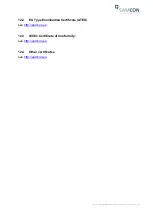
Doc.-ID: 220518-PT20BAU-SS-Ex Installation Manual rev.01.docx, Page 9 of 24
4
Area of application
The lights of the liteServer
®
series are intended to illuminate plants or processes in haz-
ardous indoor and outdoor areas. When using the luminaire, adhere to the data specified
on its type plates and indicating labels! Applications other than described above are
not
allowed without written permission from SAMCON Prozessleittechnik GmbH.
Attention!
Observe the instructions on the type plates and indicating labels!
Attention!
If you use the liteServer
®
in the mining sector with a “high” risk of me-
chanical hazard, you must provide an appropriate device ensuring pro-
tection of translucent parts (accessories).
Attention!
The liteServer
®
with the optical flange VA2.x.Kx.BOR5 is allowed to be
used in the mining industry (ATEX group I) only with a reduced temper-
ature range (-
30°C…+135°C)! The liteServer with the model key T20-
VA2.x.Kx.BOR5 must also not be used in other hazardous areas with
potentially "high" risk of damage caused by mechanical stresses (ATEX
group II)!
Attention!
The liteServer
®
devices with model key T20-
VA4.1K.PS1…, as well as
T20-
VA4.3.PS1… (optical thermoplastic) must generally not be used for
applications in the mining industry (ATEX group I), nor in other hazard-
ous areas with potentially "high" risk of damage caused by mechanical
stresses (ATEX group II)!
Attention!
The liteServer
®
devices with model key T20-
VA4.3.K1.PS1…, as well as
T20-VA2.x.Kx.BOR5 may only be used as a stationary device (not
hand-held)!
Attention!
The liteServer of type BCL2x contains inherently safe optical laser radi-
ation of λ655nm (op is) with an effect in the hazardous area. The
liteServer luminaire of type BCL2x must not be used in applications in
the mining industry (ATEX equipment group I). In IIC gas atmospheres,
the temperature classification is limited to T4. Moreover, special laser
protection provisions as defined in the latest version of the DIN EN
60825-1 Standard, as well as safety instructions in the device documen-
tation must be observed. Never look directly into the optical path! When
























